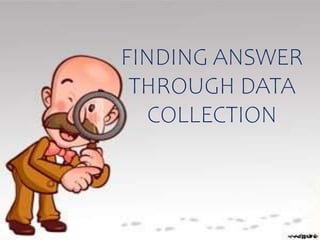LESSON-12-FINDING-ANSWER-THROUGH-DATA-COLLECTION.pptx
•Download as PPTX, PDF•
0 likes•705 views
This document discusses data collection through observation. It defines observation as personally watching and interacting with research subjects to record what they do and say in their natural environment. This provides evidence to support research claims. Two main types of observation are discussed: participant observation, where the researcher takes part in activities, and non-participant observation, where the researcher detachedly watches without involvement. Methods include direct observation, indirect observation looking at past traces, continuous monitoring over time, and spot sampling at specific moments. The document concludes with an activity where students observe and record classmates' profiles.
Report
Share
Report
Share

Recommended
Recommended
More Related Content
What's hot
What's hot (20)
THE IMPORTANCE OF QUALITATIVE RESEARCH ACROSS FIELDS OF.pptx

THE IMPORTANCE OF QUALITATIVE RESEARCH ACROSS FIELDS OF.pptx
Q3-M2_3Is_Identifying the Problem and Asking the QuestionsV4.pptx

Q3-M2_3Is_Identifying the Problem and Asking the QuestionsV4.pptx
Chapter 2. Identifying the inquiry and stating the problem (Practical Researc...

Chapter 2. Identifying the inquiry and stating the problem (Practical Researc...
Qualitative research and its importance in daily life

Qualitative research and its importance in daily life
Understanding data and ways on systematically collecting data

Understanding data and ways on systematically collecting data
Similar to LESSON-12-FINDING-ANSWER-THROUGH-DATA-COLLECTION.pptx
Similar to LESSON-12-FINDING-ANSWER-THROUGH-DATA-COLLECTION.pptx (20)
Observation methods of data collection in behavioral science

Observation methods of data collection in behavioral science
Recently uploaded
https://app.box.com/s/tkvuef7ygq0mecwlj72eucr4g9d3ljcs50 ĐỀ LUYỆN THI IOE LỚP 9 - NĂM HỌC 2022-2023 (CÓ LINK HÌNH, FILE AUDIO VÀ ĐÁ...

50 ĐỀ LUYỆN THI IOE LỚP 9 - NĂM HỌC 2022-2023 (CÓ LINK HÌNH, FILE AUDIO VÀ ĐÁ...Nguyen Thanh Tu Collection
Recently uploaded (20)
Benefits and Challenges of Using Open Educational Resources

Benefits and Challenges of Using Open Educational Resources
Sectors of the Indian Economy - Class 10 Study Notes pdf

Sectors of the Indian Economy - Class 10 Study Notes pdf
Overview on Edible Vaccine: Pros & Cons with Mechanism

Overview on Edible Vaccine: Pros & Cons with Mechanism
UNIT – IV_PCI Complaints: Complaints and evaluation of complaints, Handling o...

UNIT – IV_PCI Complaints: Complaints and evaluation of complaints, Handling o...
Solid waste management & Types of Basic civil Engineering notes by DJ Sir.pptx

Solid waste management & Types of Basic civil Engineering notes by DJ Sir.pptx
50 ĐỀ LUYỆN THI IOE LỚP 9 - NĂM HỌC 2022-2023 (CÓ LINK HÌNH, FILE AUDIO VÀ ĐÁ...

50 ĐỀ LUYỆN THI IOE LỚP 9 - NĂM HỌC 2022-2023 (CÓ LINK HÌNH, FILE AUDIO VÀ ĐÁ...
INU_CAPSTONEDESIGN_비밀번호486_업로드용 발표자료.pdf

INU_CAPSTONEDESIGN_비밀번호486_업로드용 발표자료.pdf
Jose-Rizal-and-Philippine-Nationalism-National-Symbol-2.pptx

Jose-Rizal-and-Philippine-Nationalism-National-Symbol-2.pptx
LESSON-12-FINDING-ANSWER-THROUGH-DATA-COLLECTION.pptx
- 7. Objective: •The learner plans data collection and analysis procedures (CS_RS11-IVa-c- 3)
- 8. FINDING ANSWER THROUGH DATA COLLECTION OBSERVATION
- 9. OBSERVATION • A technique of gathering data whereby you personally watch, interact, or communicate with the subjects of your research.
- 10. • It lets you record what people exactly do and say in their everyday life on Earth.
- 11. • Through this data gathering technique, proofs to support your claims or conclusions about your topic are obtained in a natural setting.
- 12. • Your presence as the researcher in the area where the subjects are situated, give authenticity to everything you get to observe among the subjects. • Watching and listening to your subjects then recording what you’ve observed about them are the reasons many consider observation the foundation of all research methods.
- 14. 1. PARTICIPANT OBSERVATION The observer, who is the researcher, takes part in the activities of the individual or group being grouped.
- 15. • To record your findings through this type of observation, use the diary method or logbook.
- 16. • The first part of the diary is called descriptive observation. It describes the people, places, events, conversation, and other things involved in the study.
- 17. • THE SECOND PART OF THE DIARY IS CALLED NARRATIVE ACCOUNT THAT GIVES YOUR INTERPRETATIONS OR REFLECTIONS ABOUT EVERYTHING YOU OBSERVED.
- 18. 2. Non-Participation or Structured Observation • This type completely detaches you from the target of your observation. You just watch and listen to them do their own thing, without you participating in any of their activities. • Checklist- is used in recording of non-participation observation. It is also called Observation Schedule.
- 19. Methods of Observation 1. Direct Observation – makes you see or listen to everything that happens in the area of observation. 2. Indirect Observation – also called behavior archaeology because here, you observe traces of past events to get information or a measure of behaviour, trait, or quality of your subject.
- 20. Methods of Indirect Observation 1. Continuous Monitoring or CM – here you observe to evaluate the way people deal with one another…. (people’s worries, anxieties, habits, problems…)
- 21. 2. Spot Sampling – first done in behavioral psychologists in 1920 with a focus on researching the extent of children’s nervous habits as they would go through their regular personality development. For a continuous or uninterrupted focus on the subjects, you record Your observation through spot sampling in an oral manner, not in a written way.
- 23. GROUP ACTIVITY • Sit with your group mates (research group) • Observe and gather your classmates’ profile. Choose only 1 profile. • In a piece of cartolina, write the profile and the corresponding number in a pictorial or tabular form. • Present your findings to the class. • The output of the activity will be given points.